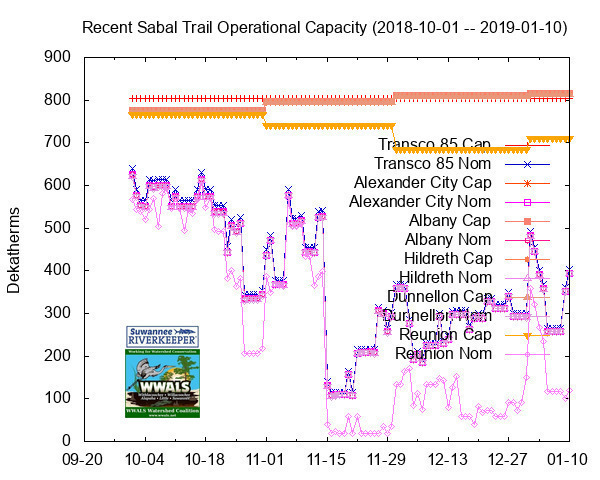Way back in 2014 I calculated that half the right of way acreage of the Sabal Trail fracked methane pipeline could produce just as much electricity, cheaper, faster, taking no land, using no cooling water, risking no leaks or explosions. Solar is even cheaper now, doubling deployed capacity every two years, and even Duke, FPL, and Georgia Power are building solar farms everywhere. So why do utilities persist in building more pipelines?
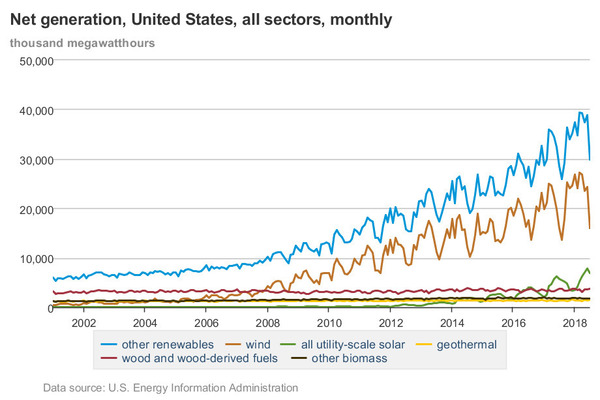
Net generation, United States, all sectors, monthly, U.S. EIA.
Every electric utility can read that chart from the U.S. Energy Information Agency, which shows wind (the middle orange line) and solar (the green line coming up from the bottom) adding up to almost all of “other renewables” (the top blue line), with nothing else growing like that. All the pipelines rammed through regulatorially captured agencies don’t come close to those kinds of exponential growth rates. Only solar and wind are growing like compound interest. So why are utilities still pushing pipelines?
If you had a guaranteed annual profit of 11% or more, and federal eminent domain letting you take land from private owners and states, and ambition to sell fracked methane overseas, you might keep building pipelines.
Or you might realize solar, wind, and batteries are already taking over, with twice as much investment as fossil fuels, while more coal plants closed in the past two years than the previous two, nobody but Southern Company is crazy enough to build new nuclear power plants, while more of them close, and so-called natural gas is the next to go down.
Solar and wind have been cheaper than all fossil fuels for years, and for more years have been cheaper than nuclear. As former FERC Chair Jon Wellinghoff says, by about 2023 solar power will overtake and pass every other source of power in the U.S. Solar power will win like the Internet did.
You might realize the electric utility that learns how to leverage sun, wind, and batteries will be the utility still standing when the others go the way of landline telephone companies 25 years ago when the Internet shot up like a rocket, just like solar power is doing now. You might not want to have to declare bankruptcy like Pacific Gas and Electricity (PG&E). You might realize that might cause a crisis of confidence on Wall Street. You might even not want to burn down California or pollute rivers or take land from people or roast the planet.
Oh, wait, that would mean a utility with a conscience. Which would require taking over its board. Which has been done before, such as when Cobb EMC suddenly gave up building a coal plant and went for solar instead, after coal opponents got elected to a majority on its board.
See for yourself. Solar Farms Sprouting In Kauai & Florida, Steve Hanley, CleanTechnica, 9 January 2019,
More utility scale solar farms are coming online in Kauai and Florida as America’s electricity providers increase their commitment to renewables. Hawaii has some of the most aggressive renewable energy goals of any state in the union, primarily because its utility rates are higher than any other state. Being out in the middle of the Pacific, it has relied for a century on diesel-powered generators for its electricity.

Kauai solar power plant
Credit: Kauai Island Utility CooperativeKauai Adds 28 MW Solar Power Plant
The northernmost island of Kauai began a transition to solar power last year when its local utility company, the Kauai Island Utility Cooperative, signed a power purchase agreement with Tesla. The California company built and installed a 13 megawatt solar farm and added 52 MWh of battery storage using 272 Powerpacks.
28 MW? That, that’s nothing!
New Duke Energy Florida Solar Power Plant
Florida is at the opposite end of the scale when it comes to embracing solar. In 2015 and 2016, a consortium of power companies spent millions of dollars to promote a change to the state’s constitution that would have effectively banned rooftop solar systems. As I write this, I am in Florida and can attest that in the last month, I have seen exactly one residential solar installation. Such a waste of all the glorious sunshine that pours down on the state every day.
Yet the people of Florida saw through that astroturf fake solar amendment and voted it down! Florida and Georgia didn’t even fall for the ALEC-pushed solar connection fee, although Virginia among other states did.
Duke Energy Florida was one of the members of that cabal, whose message was essentially, “It’s our grid, dammit, and we will decide who gets to use it and how.” But economics will not be denied. Duke and its confreres may not want you to have solar power, but it is more than happy to have the sun provide it with electricity. In a January 8 press release, it announced that its 74.9 megawatt Hamilton solar power plant in Jasper near the Georgia border is now in operation. Construction began in July of last year. Below is a video from the company showing a drone’s eye view of its solar facilities in Florida.
That one Hamilton County Solar plant is halfway to enough electricity to close Duke’s Suwannee Power Plant, on the Suwannee River in Suwannee County, west of Live Oak and south of Suwannee River State Park. Right next to that power plant Duke already built 8.8 MW of solar panels. Unfortunately, they did it by chopping down trees.
This Hamilton Solar Farm was on center-pivot agricultural land that was notorious for dust storms. More solar farms replacing such marginal agricultural use could seriously improve the fertilizer leaching problem, which is causing algae blooms and other problems in springs and rivers. Florida’s Basin Management Action Plans (BMAPs) quantified the problem as needing 85-92% reduction in nitrate leachate.
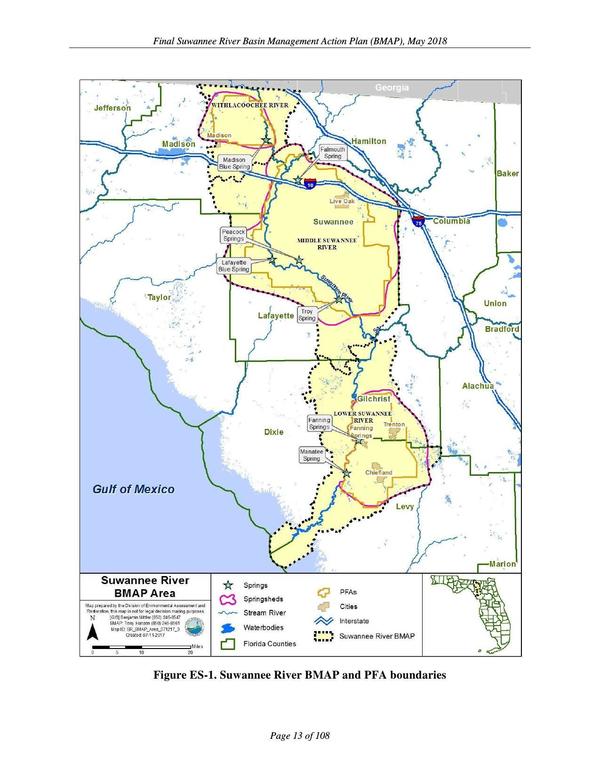
Suwannee River BMAP and PFA boundaries, The Problem, in
Final Suwannee River BMAPs, May 2018
Unfortunately, they do not include any real path to get there, only the same Best Management Practices (BMPs) such as cover crops and crop rotation that haven’t produced any improvement in the past two decades. Solar farms replacing some such marginal agriculture will help.
The Hamilton Solar Farm is also right next to the Sabal Trail fracked methane pipeline, of which Duke is an 8.5% owner. The irony.
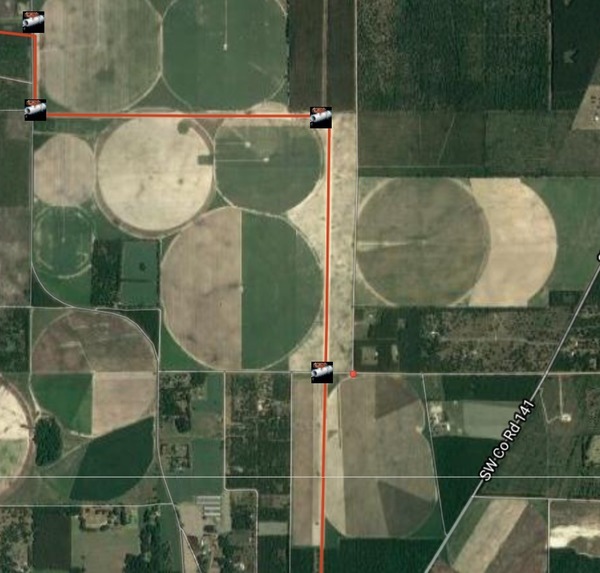
SW 69th Drive and SW 40th Avenue, in Sabal Trail path digitized by WWALS.
Duke is building nine or more of these throughout Florida. They’re doing it as part of a settlement for permanently stopping their failed Levy County nuclear project.
That, too, that’s nothing.
All this good news needs a little context. The company has a goal of having 700 MW of installed solar capacity by 2022. Its total generating capacity in Florida is 9,300 MW. By lightning like calculation, solar will represent less than 8% of its energy mix three years from now. That’s not to say adding more solar farms isn’t good news, but boasting about getting less than 8% of its electricity from solar power in a state that is blessed with abundant sunshine is what my old Irish grandmother would call damning with faint praise.
Duke has been building solar power in North Carolina and South Carolina for years. Yet it just commissioned a gas power plant in Crystal River, Florida, at the end of Sabal Trail’s Citrus County Pipeline. Presumably that’s where most of Sabal Trail’s gas is going, since Sabal Trail can’t even get it all the way to the end of its line.
The $4 billion price tag for Sabal Trail is paid by customers of
Florida Power and Light (FPL).
Yet Sabal Trail gas isn’t getting to FPL.
And FPL just build at 74.9 MW solar plant
in Suwannee County, Florida, clearly visible from I-10.
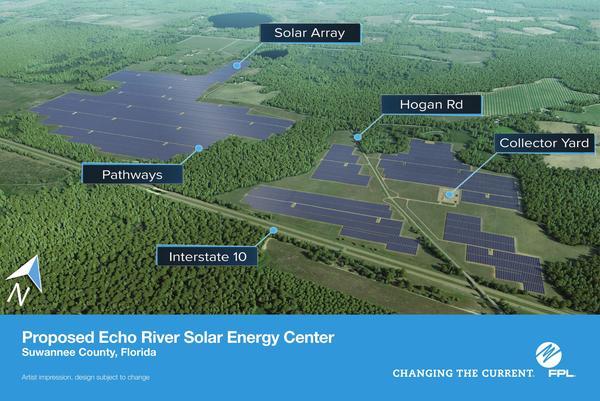
And another in Columbia County, visible from both I-10 and I-75.
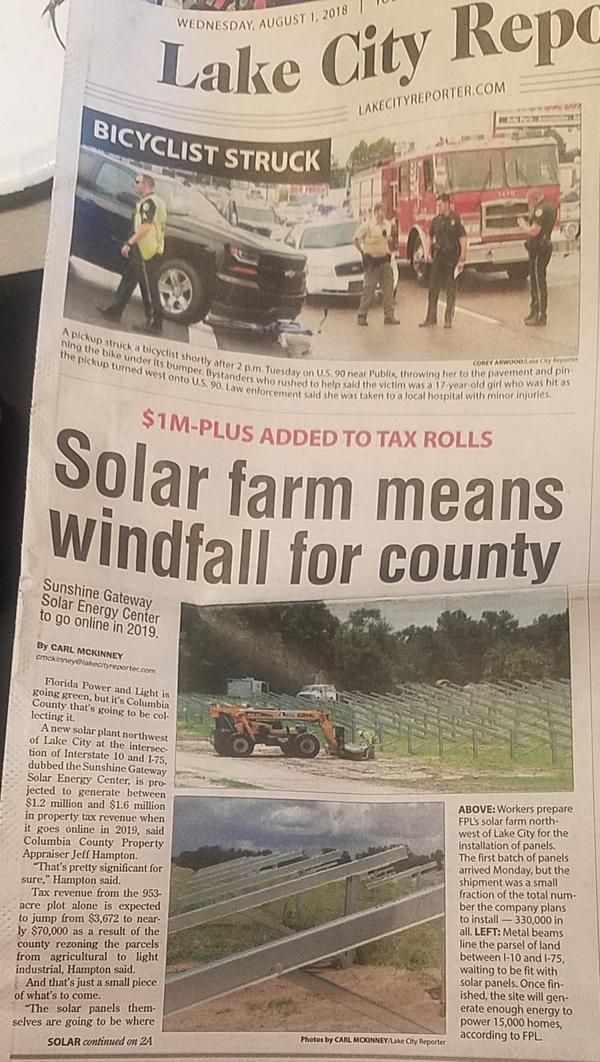
Solar photos: Carl McKinney, Lake City Reporter. Sorry I forgot who sent me this picture of the newspaper front page.
Have you ever heard any local government call a pipeline a windfall? Well, that’s what Columbia County called FPL’s Columbia County Solar Farm.
A year ago, FPL parent company NextEra Energy, in its Quarterly Earnings Call, started bragging about being a world leader in solar and wind power and only mentioned Sabal Trail in one paragraph. FPL never mentions Sabal Trail at all in later Earnings Calls.
All the utilities know solar and wind are the wave of the future. So why do they keep pushing pipelines? In addition to the guaranteed profit gravy train, they can’t charge for fuel for solar and wind.
But just like landline telephone companies when the Internet came along, it’s adapt or die, utilities. If you can’t do it, microgrids will take over, or some upstart will take your place. Go out like PG&E, or learn how to manage solar, wind, and battery power.
You can all read this chart, utilities. You all know the history of incumbent telephone companies falling before similar exponential growth of the Internet, because your own think-tank, Edison Electric Institute, told you about that way back in 2013.
Pipeline opponents, water protectors, just plain folks: stop buying utility propaganda! Solar and wind have already won the energy market. Utilities are just trying to convince you to let them cash in before the whole fossil fuel industry goes belly-up. Don’t let them.
-jsq
Investigative reporting costs money, for open records requests, copying, web hosting, gasoline, and cameras, and with sufficient funds we can pay students to do further research. You can donate to LAKE today!
Short Link:
